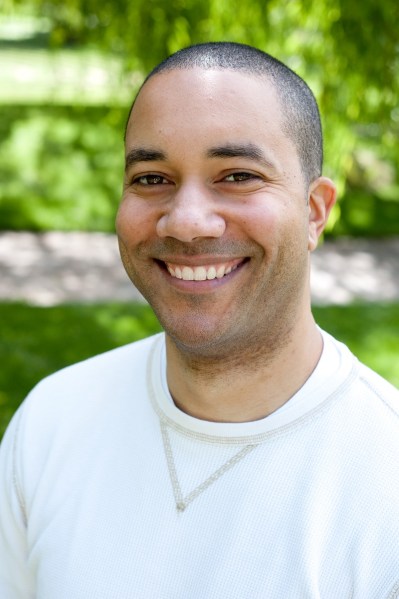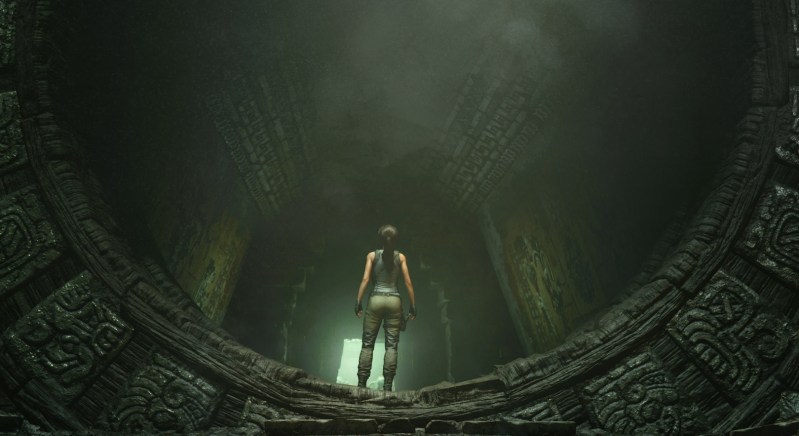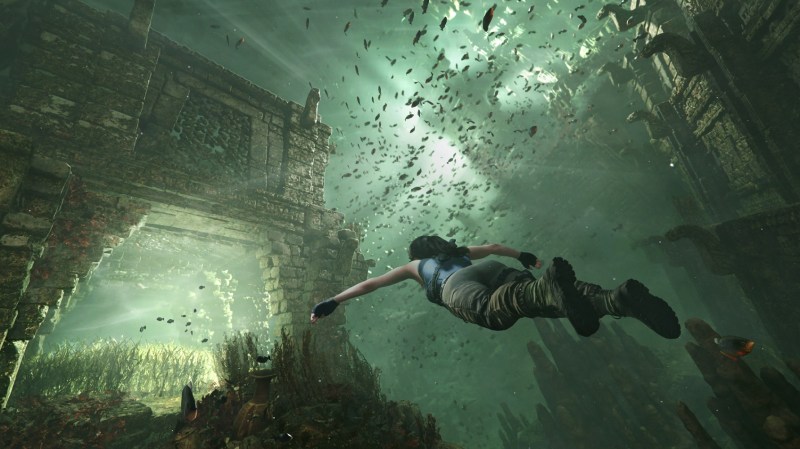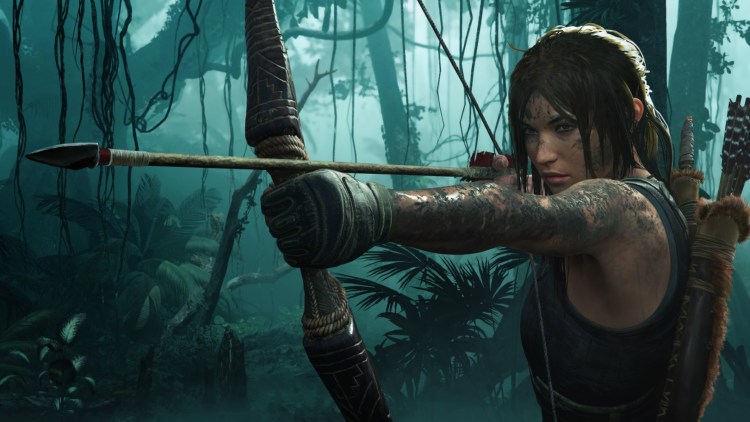Shadow of the Tomb Raider debuted on Friday as the third and final part of Lara Croft’s coming-of-age trilogy as an adventurer. Square Enix’s reboot of Lara began with Tomb Raider in 2013 and continued with the coming of age tale in Rise of the Tomb Raider in 2015.
And with this latest installment, critics are arguing about whether she’s a neocolonialist and whether she’s become too mean or the developers are too mean to her — or if she’s really Lara Croft at all.
I’ve argued that Croft has become a three-dimensional character, a dangerous and brutal killer who isn’t yet the swaggering female icon portrayed by Angelina Jolie in the Tomb Raider movies. She has inner conflicts about her single-minded pursuit of Trinity, the evil organization that killed her father and is set on controlling the world. She’s now a seasoned adventurer and is self-assured, but she faces a stinging rebuke in the beginning of this game from her friend Jonah who criticizes her for ignoring the plight of flood victims in her pursuit of Trinity and an artifact.
As imagined by Eidos Montréal and Crystal Dynamics, this Lara is still likable because she still feels the burdens of painful memories from the past and a self-doubt planted by Jonah. Somewhere in the Mayan and Peruvian jungles, she discovers who she is, musters the will to survive, and becomes merciless in her pursuit of all enemies.
June 5th: The AI Audit in NYC
Join us next week in NYC to engage with top executive leaders, delving into strategies for auditing AI models to ensure fairness, optimal performance, and ethical compliance across diverse organizations. Secure your attendance for this exclusive invite-only event.
I finished the game and interviewed Rich Briggs, senior brand director of Crystal Dynamics, about what the developers intended to convey in this game, which is available now on PlayStation 4, Xbox One, and PC. We tried to avoid spoilers in our discussion, but we discussed the major points of the game.
Here’s an edited transcript of our interview.

Above: Rich Briggs is senior brand director for Tomb Raider at Crystal Dynamics.
GamesBeat: How has the launch gone for you?
Rich Briggs: It’s full-on in progress. It’s gone very well. We’re very excited. It’s obviously been a long road to get here. I’ve been working on Shadow of the Tomb Raider for close to three years now. It’s exciting to have the game in people’s hands and see the positive responses so far.
GamesBeat: How did you yourself look at the transition from Tomb Raider to Rise of the Tomb Raider to this one — as far as Lara’s character goes?
Briggs: This was definitely something that was very important to us. We knew that in Tomb Raider, Lara was trapped in a situation she didn’t want to be in. She was trying to make her mark, and she discovered that she had what it takes to be a survivor.
You move forward to Rise of the Tomb Raider and our evolution of that was, OK, Lara now recognizes that she has a place in the world. She doesn’t know exactly what it is yet, but she does know that she is uniquely qualified to fight against Trinity. She can go into these harsh environments. She has the skill and the drive, what it takes to survive. She puts herself in harm’s way to take down Trinity.
Now, we move forward to Shadow of the Tomb Raider, and since a lot of Lara’s development and struggle had been about external forces pushing against her, we wanted to make her most difficult conflict an inner one. You raised this in your review, which I liked, talking about how Lara has to look inside and not become the monster that she’s facing. This was really important to us. Lara being at the height of her skills, being the most confident she’s ever been, gave us a lot of opportunity. It meant that Lara could now, instead of just being on this easy trajectory toward becoming the tomb raider, she has to decide what kind of tomb raider she’s going to become.

Above: Just another tomb.
As you know from playing the game, her being so headstrong and feeling like she’s the only one who can stop Trinity means she takes the artifact that triggers the Maya apocalypse. And then, Lara being who she is, she realizes her mistake and she sets about what she can to make it right. But it really is, along that way — her darkest hour is about those times when she is coming close to becoming the monster that she’s fighting. The aspirational journey she has to go on is about deciding, “How do I push through this?” That’s what makes it her defining moment — becoming the tomb raider she’s meant to be, which is one who is not like Trinity. She can’t say the ends justify the means. She can’t sacrifice her own humanity as she’s fighting against Trinity.
We thought that was an interesting way to show her character development. You know where she’s eventually getting, but how she actually got there is maybe a little different from you might expect.
GamesBeat: I don’t know if there’s a slightly spoiler-less description you could have for the ending and how the story turns out. Especially relating to her parents. How did you see that particular scene and its importance to all of this inner conflict?
Briggs: You’re right that it’s a little difficult to go into detail without going into spoiler territory, but — one thing that’s important is, Lara has lost so much. Obviously, she learns in Rise of the Tomb Raider that Trinity is responsible for her father’s murder. She lost her mother before that. Lara has spent more of her time around the dead than around the living. Even though she’s doing what she loves to do and what she feels she’s meant to do, raiding tombs and spending her time fighting against Trinity and going through everything she’s been through has made it difficult for her to form human relationships.
You see a lot of that come to a head in Shadow of the Tomb Raider. The stakes are so high, and Lara feels so much pressure on her shoulders with respect to the Maya apocalypse, that that can even fray her relationship with Jonah. It makes it very difficult for her to engage with the other people she meets along the journey. We have a couple of moments that are a bit more lighthearted where we show Lara a little awkward in conversations. We have other moments that are very dramatic, about how Lara has difficulty allowing others to help her on this journey.
Where we tried to end is Lara understanding what she has to let go of and what she has to internalize as being truly important in life.
GamesBeat: The relationship with Jonah was interesting. I wondered whether it was something you considered changing. He comes pretty close to saying that he really cares for her. Did it ever come into the heads of the writers that he could fall for her, beyond just being her sidekick?
Briggs: We’ve always seen their relationship as a big brother and little sister. Jonah calls her his “little bird,” which is an affectionate reference to his culture. The thing about Jonah is that he has always followed Lara on all these adventures in the reboot. He’s always been there for her.
And the thing I think is so powerful around the narrative and what we were trying to do when we were looking at what kind of risks we should take with Lara’s character development and their relationship, was in that fraying of the relationship, in that situation where Lara has become so obsessive about trying to take down Trinity and feeling like she’s the only one who can do this, that she’s pushing away one of her dearest friends. The idea that there could be moments where Jonah is basically yelling at her — it’s not just about you, and we’re not going off on the next step and just ignoring the devastation around us, like when the first flood hits and the town is just devastated — those moments are really powerful.
It never really crossed our minds to go into romantic territory — to directly answer your question. It was always about, this is one of her closest friends. He looks at her as his sister, someone he always has to be there for. The fact that their relationship would come under such strain I think is very telling about how driven Lara is, how much of an internal conflict she’s trying to push through, how much she’s been forced to go through, how much she’s sacrificed and what that’s done to her, and her ability to have relationships with people.
The stakes — Lara’s been through a lot, but you kind of have to see where she’s coming from. She is one of the few people who can stop Trinity. It’s the fate of humanity at [stake] here. When you’re faced with the apocalypse, there are some hard choices to make.
GamesBeat: I thought you went fairly far into making her more dangerous. But it seemed like you also pulled back from how far that could have gone. She was looking pretty mean in some of those scenes — like when she comes out of the water at the oil refinery. There’s a push to show that she’s changing, I guess, but you’re also pulling back from where it could go.
Briggs: That was absolutely a conscious decision on the part of the narrative. Lara herself is descending. She’s getting closer to that line. Once she crosses that line too many times, it becomes difficult to pull back from it without losing a part of herself.
When we talk about the title, “Shadow of the Tomb Raider,” part of that deals with the shadow that casts in terms of the Maya apocalypse. Part of it deals with stepping out of her father’s shadow. But I would say the majority of that, people come to realize, is about what type of tomb raider she could become. That inner darkness she starts to skirt the line around — you called out one of those moments. The oil refinery is absolutely meant to be a place where Lara is crossing a line.
What makes her special and what I think makes her journey compelling, is that she does recognize this. She does pull herself up. She realizes what kind of tomb raider she’s meant to be and what kind of tomb raider she has to become. That’s why we refer to this as her defining moment. She makes conscious decisions about how she is going to do what she does and about what her place in the world is going to be.

Above: Is Lara Croft a neocolonialist?
GamesBeat: There were at least a couple of reviews out there that labeled Lara as a “neocolonialist.” I felt like they were off the mark, but they could have been put to rest by some kind of comment Lara could have made about — either respecting these cultures or somehow having them confront her. “Is that the reason you’re here, just to take our stuff and put it in the British Museum?”
Briggs: When we were looking at how we portray different cultures, there were a couple of things that we held as important. One, we worked with [a] historian, even though it was not ever meant to be a historically accurate representation of these cultures. We have a narrative that we want to tell. We borrow and combine different elements from different cultures in order to do that. But we did want it to feel like it could take place. It could be rooted in historic events.
The second thing we did was work with a cultural consultation group to make sure that we’re portraying these cultures as respectfully as possible. It’s certainly never our intention to [do] anything disrespectful toward any culture or make it seem as if Lara herself is disrespectful of those cultures.
There’s always something we can learn, and it always comes from a place of, how can we respectfully tell a narrative about a culture that’s been untouched by modern civilization? They’re in a difficult situation, and Lara is coming in and doing what she thinks is right. And I think a lot of that character growth we talked about is also important in terms of how Lara acts when she gets into Paititi, the hidden city. The relationships she forms over the course of the game — again, I don’t want to spoil too much, but as you know, there are scenes where she has certain revelations with people. There are scenes where she has to help people in certain ways. There are scenes where they have to help her.
We tried to make a point of Lara coming in and realizing that it’s not just all about her. She does have, by the end of the game, a much wider view of Paititi and, as a result, of her place in it.
GamesBeat: I wonder if I was supposed to become aware of that a bit more. There wasn’t a cinematic kind of scene that really drove that home in Paititi. Maybe I could have used something to see that more.
Briggs: No, that’s a good thought. We’re always listening to our fans. We always take both the positives and the constructive criticisms very seriously. We’re always looking to learn about how we can do better in our gameplay and our narrative.
GamesBeat: Part of my reaction was the one that often comes up. I’ve got a world to save here, so why am I worried about a kid who didn’t show up with a delivery when he was supposed to?
Briggs: And that’s one of those — it’s such a difficult balance. If we were being 100 percent honest, you wouldn’t do anything except beeline toward the end. It’s the Maya apocalypse! Why am I collecting a second bow and grabbing pieces for my upgrades? And the game would be roughly 45 minutes long.
We try to make sure that there’s at least a bit of a narrative support for the side quests that you’re doing. If you think about it, OK, we take you on the roller coaster ride, and then, we drop you into a hub. You have this huge space. In Shadow of the Tomb Raider, we have the biggest hub we’ve ever delivered in a Tomb Raider game. There’s tons of stuff to do.
To your point, why should I trouble with all this? We try to position it as, “If you go into a challenge tomb, you’ll be rewarded with a skill that will ultimately make Lara better equipped for the fight against Trinity.” If you go into a crypt, you’ll find a piece of an outfit or a weapon that improves Lara’s skills. When you do these social quests for people, you gain experience points. Yes, there’s a bit of a balance and a bit of, OK, suspend your disbelief for the sake of gameplay. But we try to make sure you feel like there’s value to the things you’re doing. It’s ultimately helping Lara to become better equipped to take on Trinity and beat the apocalypse.

Above: I got lost swimming with the piranhas.
GamesBeat: Are there some postmortem thoughts you have on any interesting things you’ve seen in reviews or other comments people have made?
Briggs: Right now, we’re still very much in launch mode. We’re consuming all the feedback and reading all the reviews. We’ll certainly be diving in and dissecting and figuring out what things we can learn from and what things we did well, things we know we want to continue as we go into our DLC releases. We’re always looking on the point of how we can get better.
GamesBeat: I’m curious about the big animal fight scene and whether certain things had to be considered in putting that one together. It’s a very tense scene, just like the bear fight in Rise of the Tomb Raider.
Briggs: In the Tomb Raider games — and this has been the case in Tomb Raider 2013, Rise of the Tomb Raider, and Shadow of the Tomb Raider — we always look at the world as being an enemy. The world is a character. Not an enemy in an antagonistic way but in that the world has secrets, and it is trying to protect those secrets. It uses a wide variety of tactics to do that. Sometimes, there are natural barriers. Sometimes, there are catastrophes. Sometimes, it’s just treacherous traversal. Sometimes, it’s natural predators. It’s all trying to protect the secrets of history, those lost truths.
Lara, as I mentioned earlier, is one of the few people who can go into these very inhospitable environments and survive. She can push past physical, mental, emotional barriers that would break people like you and me down. Or, well, I can’t speak for you but at least me. I’d die in about 45 minutes in the places Lara goes. She’s able to not just survive, but now, in Shadow of the Tomb Raider, thrive in the situations.
The big fight you’re talking about, or the bear fight in Rise of the Tomb Raider, is the world saying, “This is the alpha predator. This is a huge line of defense around one of my secrets.” It’s like the world is testing Lara. Are you ready for this secret? Are you ready to go further than most people can? We like to have a bit of a narrative without spoiling too much. That fight has a lot of foreshadowing to it because people in the area are talking about it as this mythical creature. We want to have a narrative tied to it, but in the end, it’s the world pushing back on Lara and Lara showing how she is one of the few people [who] can push through when it comes to those situations.

Above: Shadow of the Tomb Raider has majestic landscapes.
GamesBeat: It was also interesting that it’s a supernatural world just like in the other games.
Briggs: Absolutely. We surface that a little earlier this time around. Again, it’s a theme of the reboot franchise, that the spirit of immortality, the Maya apocalypse — these things are real. They just haven’t been discovered and aren’t shown widely because people can’t get to those secrets. If the secret of immortality was easy to find, it would be a very different world. Paititi draws a lot from things like the myth of El Dorado, the city of gold. These things that Lara finds out, and that Trinity knows, are real. They’ve just been hidden and protected by the remote, hazardous places they’re in.
GamesBeat: It shows that she’s tough enough to either work with or defeat the supernatural.
Briggs: Yeah, again, she has this unique combination of skills and drive and intelligence. She’s a brilliant archaeologist. She can find these clues and figure out where to go and push herself to do all the extreme traversal and climbing to get there. We look at it as, if Lara is at the height of her skills, everything else has to escalate. The world has to get even more difficult. We add rappelling and underwater swimming. The combat has to get harder, so that’s where we get things like becoming one with the jungle, using mud as camouflage. The tombs are scarier than ever. This is a place where even the puzzle elements are trying to kill you.
It’s about upping the stakes across the board because Lara is at her most capable. She can go into these survival situations and do what most people can’t. We have to raise the stakes in order to give her and you by extension, the player, a challenge.
GamesBeat: I liked the idea of bringing a machine gun to a bow-and-arrow fight.
Briggs: [Laughs] She has been known to do that.
GamesBeat: I did feel there were places where I got lost underwater. Figuring out my way through the piranhas, that was a pretty difficult puzzle, threading that needle there.
Briggs: I have a special, angry place in my heart for the piranhas, I’ll say that as well. They’re so tough. Hiding in the seaweed was the only way I could get past them. The underwater sections — you have to find a careful balance. They have the potential to slow down a game if not implemented correctly.
We really tried to make it so you weren’t spending a ton of time underwater but enough time that when you did have to go underwater, it shouldn’t feel good. We wanted it to feel like a survival situation. We wanted it to feel very claustrophobic at times, wondering if you were going to make it through that tunnel. That was modeled after some research we did. We looked at the cenotes down in Mexico, this tunnel system where people had to leave their oxygen behind to squeeze through these very narrow tunnels. They didn’t know what was on the other side, but they would do it to explore.

Above: A puzzling contraption.
We tried to draw from that and make it so, yes, sometimes, you have to make your way through an underwater situation. Other times, it’s optional because there’s a challenge tomb at the end of the tunnel or a treasure or a resource you need. It was always done through that lens of survival action.
GamesBeat: Have you always seen Lara Croft as different from something like the Uncharted series or Indiana Jones in some definite way?
Briggs: One of the things that separates Lara is — partly her drive, partly that unique combination of skills I was talking about, the survival action lens we try to view everything through. We look at it as cinematic survival action. The tombs are also a big differentiation. We obviously draw inspiration from movies like Raiders of the Lost Ark. We have great respect for the Uncharted series. Those are games we love playing. I think that Lara has sort of defined this unique combination of being a brilliant archaeologist, having that fast-paced, movement-based combat, her ability to push beyond boundaries that would stop most people. Really, to me, it feels like a special combination. It makes her unique.
GamesBeat: At the end of the third game, do you see this as some kind of demarcation? If there’s a next game that’s coming or being considered, would that change Lara in some way? In particular, I worry that the wise-cracking, swaggering, Angelina Jolie version of Lara is the one that comes next in time.
Briggs: Obviously, right now, we’re very focused on the launch of Shadow of the Tomb Raider. We have some DLC coming, which will continue to tell stories in the world. You’ll get a challenge tomb, a little bit of narrative and side quests that go along with that. We have seven months of that, one each month. There’s still plenty for us to tell in this story. But then, who knows? We’re always listening to our fans and reading your reviews. We’re always thinking about where Lara goes next.
GamesBeat: Any last thoughts you’d like to bring up?
Briggs: This has been a long, fun journey, longer than some people know, when it comes to working on the game. It’s exciting for us to be delivering Lara’s defining moment. The stakes couldn’t be higher. It’s a thrill to see all the support from our fans as we watch Lara become the tomb raider she’s meant to be.


